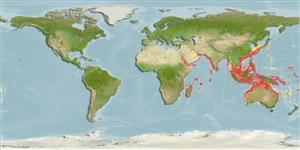Environment: milieu / climate zone / depth range / distribution range
Ökologie
seewasser; brackwasser demersal; tiefenbereich 10 - 400 m (Ref. 11441). Tropical; 26°C - 29°C (Ref. 4959)
Indo-West Pacific: Persian Gulf (Ref. 11441), off Pakistan, the west coast of India and Sri Lanka, Indonesia, the Philippines, Japan, and the north and east coasts of Australia.
Size / Gewicht / Alter
Maturity: Lm ? range ? - ? cm
Max length : 44.0 cm SL Männchen/unbestimmt; (Ref. 559); common length : 30.0 cm TL Männchen/unbestimmt; (Ref. 2872); max. veröff. Gewicht: 61.90 g (Ref. 124479)
Rückenflossenstacheln (insgesamt): 0; Rückenflossenweichstrahlen (insgesamt): 107-113; Afterflossenstacheln 0; Afterflossenweichstrahlen: 80 - 88. Eyed side brown with an irregular dark blotch on gill cover, blind side white. Blind side with 2 lateral lines (dorsal and medial). Body elongate, its depth 22 to 29% SL. Eyes with a small scaly interorbital space. Snout rounded. Rostral hook short. Corner of mouth reaching posteriorly beyond lower eye, nearer to gill opening than to tip of snout. Caudal-fin rays usually 12. Midlateral-line scales 88 to 96. Scales ctenoid on eyed side of body. Cycloid on blind side. Scale rows between lateral lines on eyed side of body 13 to 16 (Ref 9895).
Occurs in coastal areas and estuaries. May ascend upstream into the freshwater tidal zone of the Mekong (Ref. 12693). Inhabits muddy and sandy bottoms of continental shelves. Feeds mainly on benthic invertebrates (Ref. 3391). Utilized as a food fish (Ref. 3391). Marketed fresh in the Mekong delta (Ref. 12693).
Menon, A.G.K., 1977. A systematic monograph of the tongue soles of the genus Cynoglossus Hamilton-Buchanan (Pisces: Cynoglossidae). Smithson. Contrib. Zool. (238):1-129. (Ref. 5297)
IUCN Rote Liste Status (Ref. 130435)
Bedrohung für Menschen
Harmless
Nutzung durch Menschen
Fischereien: kommerziell
Mehr Information
ReferenzenAquakulturAquakultur ProfilZuchtlinienGenetikElectrophoresesVererbbarkeitKrankheitenVerarbeitungNutrientsMass conversion
Tools
Zusatzinformationen
Download XML
Internet Quellen
Estimates based on models
Preferred temperature (Ref.
123201): 16.9 - 28, mean 23.8 °C (based on 942 cells).
Phylogenetic diversity index (Ref.
82804): PD
50 = 0.5000 [Uniqueness, from 0.5 = low to 2.0 = high].
Bayesian length-weight: a=0.00417 (0.00262 - 0.00664), b=3.05 (2.91 - 3.19), in cm total length, based on LWR estimates for this species & Genus-body shape (Ref.
93245).
Trophic level (Ref.
69278): 3.9 ±0.32 se; based on food items.
Widerstandsfähigkeit (Ref.
120179): mittel, Verdopplung der Population dauert 1,4 - 4,4 Jahre. (Fec = 2,223-225,557).
Fishing Vulnerability (Ref.
59153): Moderate vulnerability (41 of 100).
Nutrients (Ref.
124155): Calcium = 118 [54, 211] mg/100g; Iron = 0.887 [0.459, 1.592] mg/100g; Protein = 18.1 [15.8, 20.4] %; Omega3 = 0.161 [0.082, 0.314] g/100g; Selenium = 81 [38, 168] μg/100g; VitaminA = 12.2 [3.6, 41.9] μg/100g; Zinc = 1.03 [0.69, 1.51] mg/100g (wet weight);
